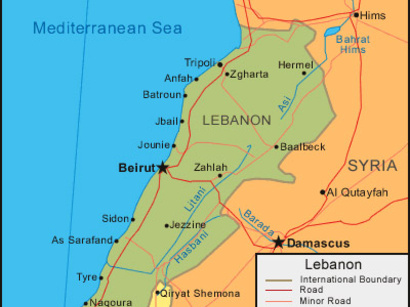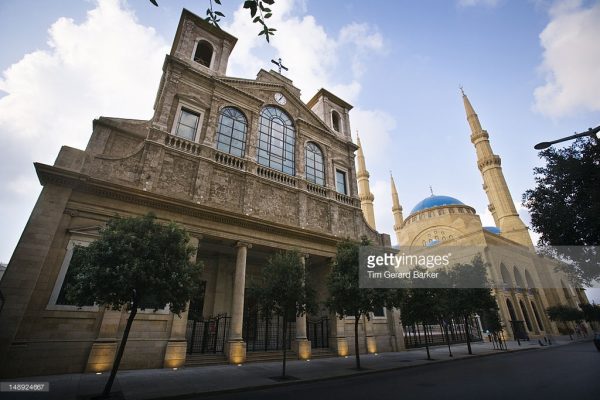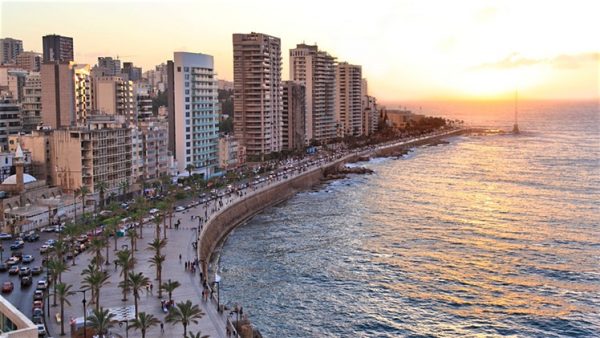
By
It is not so long – perhaps 30 years – since Lebanon was a destination to which no-one with any common sense would have ventured without good cause. It was a civil-war-torn hell-hole, a regular tattered house guest stumbling onto the evening news bulletins – an emblem of destruction whose capital, Beirut, had become a byword for carnage and conflagration.
Fast forward three decades and this country on the edge of the Mediterranean is distinctly more appealing as a holiday possibility. There are caveats to going there, certainly (see below), and its location very close to some of the Middle East’s thornier problems make it a place to which, even now, only more intrepid travellers are likely to dash.
But as it celebrates its Independence Day (today, November 22), here are a few facts about the “Paris of the East”.
1. It used to be French
Paris of the East? Where does that come from? Well, it’s a paeon of praise that has occasionally been applied to Lebanon – and Beirut in particular – over the last 60 or so years. In particular, it applies to the gilded pre-war Sixties in the country, when its capital was viewed as an alternative to the Cote d’Azur by the jet-set crowd.
But the description also tacitly acknowledges the fact that Lebanon was once under French control. Between 1920 and 1943, to be precise. Today’s Independence Day is pinned to the latter year, when Gallic rule over the country – which had been imposed in the wake of the First World War and the collapse of the Ottoman Empire – was deemed to have been thrown off. There would be French machinations in the country for another three years, but in terms of the existence of the modern Lebanon, 1943 is the key line in the sand.
2. Gallic ghosts linger
The French “mandate” over Lebanon may have lasted for “just” 23 years, but it left its imprint on the capital. Much of the east side of central Lebanon still dreams, to an extent, of Paris. The names have an Arabic tinge, but the districts of Gemayzeh and Accrafieh have plenty in common with the likes of the Marais and Saint-Germain-des-Pres. Peer more closely at the map, and the comparison becomes more obvious. Rue Gouraud in Gemayzeh is alive with small galleries and arty finesse. Rue Monot, which snakes up the hill in Accrafieh, has cafes and restaurants which would not seem out of place in Montmartre. They joy is that, unlike in Montmartre, you won’t be assailed by hawkers selling cheap plastic models of the Sacre Coeur.
3. There is a fug of smoke over the streets
France, it is fair to say, likes a cigarette. The Middle East, it is even more reasonable to comment, also loves its tobacco products. So it probably shouldn’t be a surprise to find out that, according to World Health Organisation figures, Lebanon is the portion of the planet with the third biggest appetite for smoking. Only Montenegro and Belarus light up more often. A cloud of freedom or a reason to avoid the country? Please delete as appropriate.
4. The FCO is OK with Lebanon. Mostly
This wasn’t always the case. Britain’s Foreign and Commonwealth Office has expanded and contracted its advice on travel to Lebanon in recent years, but the last change of stance (in October) opened up regions which had effectively been off-limits to UK travellers for much of this decade. As it stands, the western and central segments of the country have been declared as safe to visit – although there are asterisks in place above certain parts of Beirut, and areas along the eastern frontier. For the latest FCO position, you should click round about here.
5. The neighbours can be noisy
The prime source of FCO concern over travel to Lebanon is that the country’s relationship with its nearest, if not exactly dearest, can be somewhat fractious. In short, Syria, whose ongoing issues need little discussion, lies directly to the north and east, while Israel – with whom Lebanon fought a brief war as recently as 2006 – lies to the south.
This helps to explain the FCO’s do-not-go warnings regarding the border zones, but is unlikely to impinge on any realistic pre-planned itinerary. Aside from Baalbek (see number 7, below), the majority of the Lebanese landmarks any visitor is likely to wish to see are well within the safe areas.
6. It is the second smallest country in the Middle East
 Or the third smallest, if you include Palestine. To be specific, Lebanon is bigger than Bahrain, and smaller – at 4,036 square miles – than every other country in the region. It would fit into the Middle East’s biggest state, Saudi Arabia, some 206 times. If you extend this idea to the rest of the continent, Lebanon is also the fifth most diminutive country in Asia – only the Maldives, Singapore, Brunei and Bahrain can claim less landmass. In other words, it isn’t a super-sized state in any sense. You could feasibly see all of it in one week.
Or the third smallest, if you include Palestine. To be specific, Lebanon is bigger than Bahrain, and smaller – at 4,036 square miles – than every other country in the region. It would fit into the Middle East’s biggest state, Saudi Arabia, some 206 times. If you extend this idea to the rest of the continent, Lebanon is also the fifth most diminutive country in Asia – only the Maldives, Singapore, Brunei and Bahrain can claim less landmass. In other words, it isn’t a super-sized state in any sense. You could feasibly see all of it in one week.
7. It has the greatest fragment of Ancient Rome outside Rome

Really? That’s quite the grand statement. Pompeii, Leptis Magna in Libya, the colossal amphitheatre at El Djem in Tunisia, the scattered remains of Palmyra in Syria – all could plausibly lay claim to this title. But there is something special about Baalbek. The modern town which bears the name is practically synonymous with the Roman structures at its heart. Especially the colossal Temple of Bacchus, a second century (AD) marvel which would bear comparison to the Parthenon in Athens were it a) not a legacy of an entirely different ancient civilisation and b) in rather better condition. The one (considerable) problem is that the ruins are currently within the FCO’s no-go zone on the eastern border – but it is worth keeping an eye on the web page (and fingers crossed) that this might change. Baalbek is certainly more likely to return to the mainstream travel fray, in the immediate future, than Palmyra or Leptis Magna.
8. It makes wonderful wine

The road to Baalbek – which is, partially, at least, in the FCO’s good books – is framed by vineyards. Wine has been produced here for some six millennia – the Romans, ever keen to put the grape to party-starting use, were well aware that the Bekaa Valley (which runs up the centre of Lebanon) was perfect terrain for viticulture. This is still true in 2017. Chateau Ksara (in Ksara; chateauksara.com), arguably Lebanon’s foremost wine purveyor, is one of several producers based in the valley. It opens its doors to the public for tours and tastings.
9. The Romans were not the only ancient residents
By the time the Romans stomped their boots and sandals across Lebanon, the country had already been a seat of civilisation for a fair old time. The proof of this particular historical pudding is Byblos, a city which sits some 20 miles north of Beirut, up the Mediterranean coast. It was here that the Phoenicians, the ancient people whose influence spread right across north Africa at one point, sprang into life in the 15th century BC (or thereabouts). It can claim to be one of the oldest continuously inhabited spots on the planet – estimates suggest its beginnings could have been as early as 8800BC. Of course, little remains of this distant era, but an air of yesteryear envelops the heart of town – not least via its 12th century Crusader castle, in whose walls cannon balls are still embedded.
10. You can barely move for ancient sites
As well as Baalbek and Byblos, Lebanon has Tyre (also known as Sour), which sits close to the Israeli border – a pretty port whose Roman hippodrome has been on the Unesco World Heritage list since 1979. Despite its proximity to Lebanon’s southern neighbour, the city is currently within the FCO’s safe travel zone, and can be reached via a day trip from Beirut (it lies 50 miles from the capital). Equally intriguing Sidon (Saida) is, alas, something of a black-spot as far as the FCO is concerned (due to the presence of refugee camps). But there is ancient heritage in Beirut too – where the National Museum (beirutnationalmuseum.com) is as sublime an archaeological treasure trove as anything found in Cairo, Paris, Berlin or London.
11. You can’t really avoid Beirut’s concrete phantom

The Lebanese Civil War – the inferno which devoured the country between 1975 and 1990, and made household names of British hostages Terry Waite and John McCarthy – is far less visible on the face of Beirut than it used to be. Reconstruction work and new buildings have slowly erased (some of) the damage.
But one tombstone is still very apparent. The Holiday Inn – on Rue Omar Daouk, in the Minet-el-Hosn district – was a grand new hotel when it rolled out the red carpet in 1974. But it would quickly become a symbol of the conflict, snipers taking over its corridors, rooftop and vantage points, artillery explosions eating into its masonry. Half a century on, it is a ghost – still standing thanks to an ongoing dispute between the two companies which own is as to what, if anything, they can do with this enormous wreck of a building. It is not a landmark which you would necessarily seek out as a point of pilgrimage, but it casts a shadow over the city which can be hard to escape.
12. There are deluxe hotels galore

One of the reasons for the old Holiday Inn’s ongoing notoriety is that it stands so close to a number of its successors. Specifically, it towers above the Phoenicia Hotel, a fabulous five-star palace (phoeniciabeirut.com) with double rooms from £224 per night. This, rather than the Holiday Inn, is representative of accommodation in the Beirut of 2017. As is Le Gray, a similarly sumptuous retreat (campbellgrayhotels.com/le-gray-beirut) with doubles for £254.
13. Beirut has one of the Mediterranean’s best beaches

If uber-upmarket rooms and suites are not enough to convince you that Beirut is a sophisticated seafront city, then Ramlet al-Baida just might. The city’s prime beach waits on the west side of the centre, just south of the busy districts of Hamra and Ras-Beirut. Its sands and rolling waves are a reminder that, just like Cannes, St Tropez, Barcelona, and Valencia, Beirut is a Mediterranean city. On a hot day, it is as beautiful as any of its “rivals”.
14. Lebanon loves a bank holiday
If Ramlet al-Baida is busy on the afternoon you attempt to top up your tan, it might be because the city has taken the day off. There’s a good chance of this. Lebanon is the planet’s third most easy-going nation when it comes to public holidays. It takes 16 days a year – yes, 16 – out of the office. Only India and Colombia – 18 days – play official truant more often.
15. You can book a tour of the country
The FCO’s loosening of its restrictions on travel to Lebanon has not yet translated into a surge in package options. Tour operators you might ordinarily expect to be active in the country are yet to re-embrace it – the likes of Steppes Travel (steppestravel.com/middle-east), Cox & Kings (coxandkings.co.uk/destinations/middle-east/lebanon) and Explore (explore.co.uk/destinations/middle-east/lebanon) are still only offering warm words and attractive images in lieu of bookable itineraries.
That said, Corinthian Travel (020 3583 6089; corinthiantravel.co.uk/destination/lebanon-holidays) offers a range of trips – including an eight-day “Classic Lebanon” jaunt which calls at Tyre and Byblos as well as Beirut – from £2285 per person (not including flights). Which is a start.
Destination Lebanon (destinationlebanon.gov.lb), meanwhile, provides further details and information.
Telegraph. uk.
Leave a Reply
You must be logged in to post a comment.